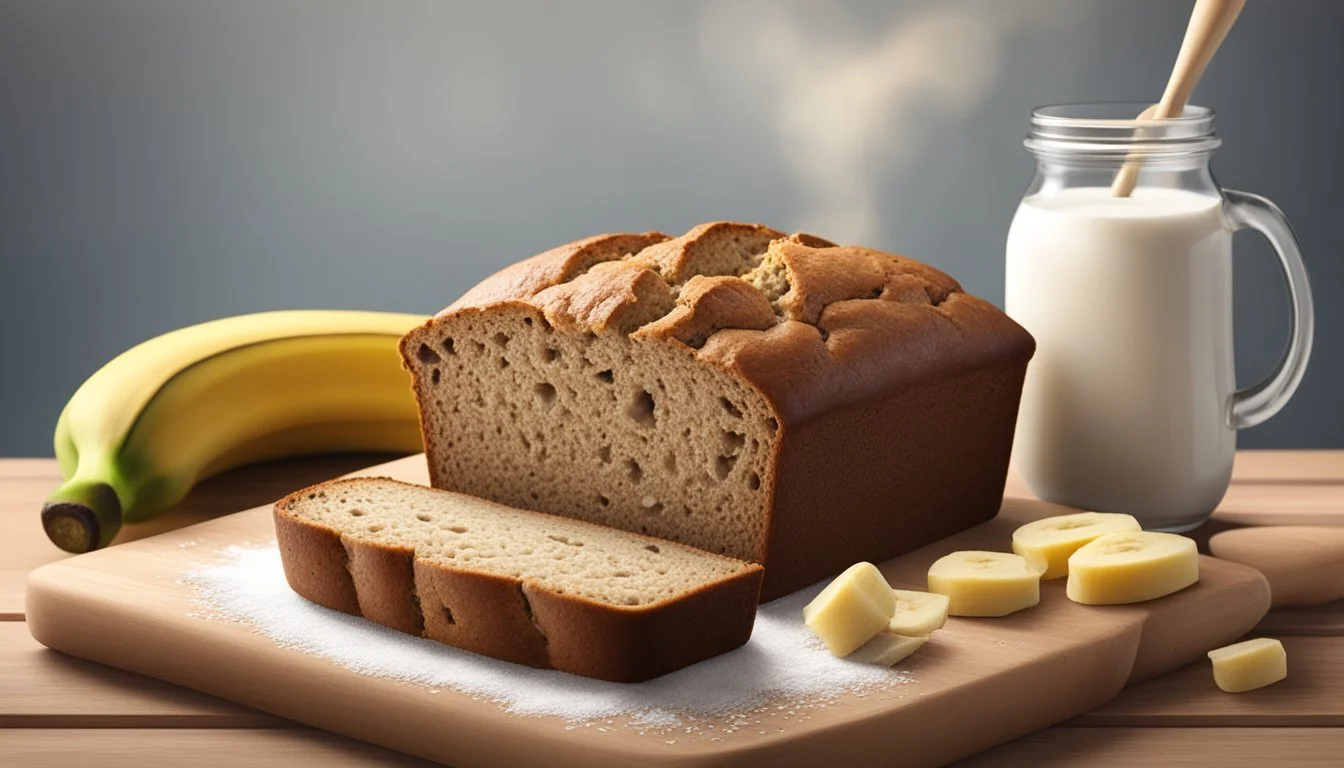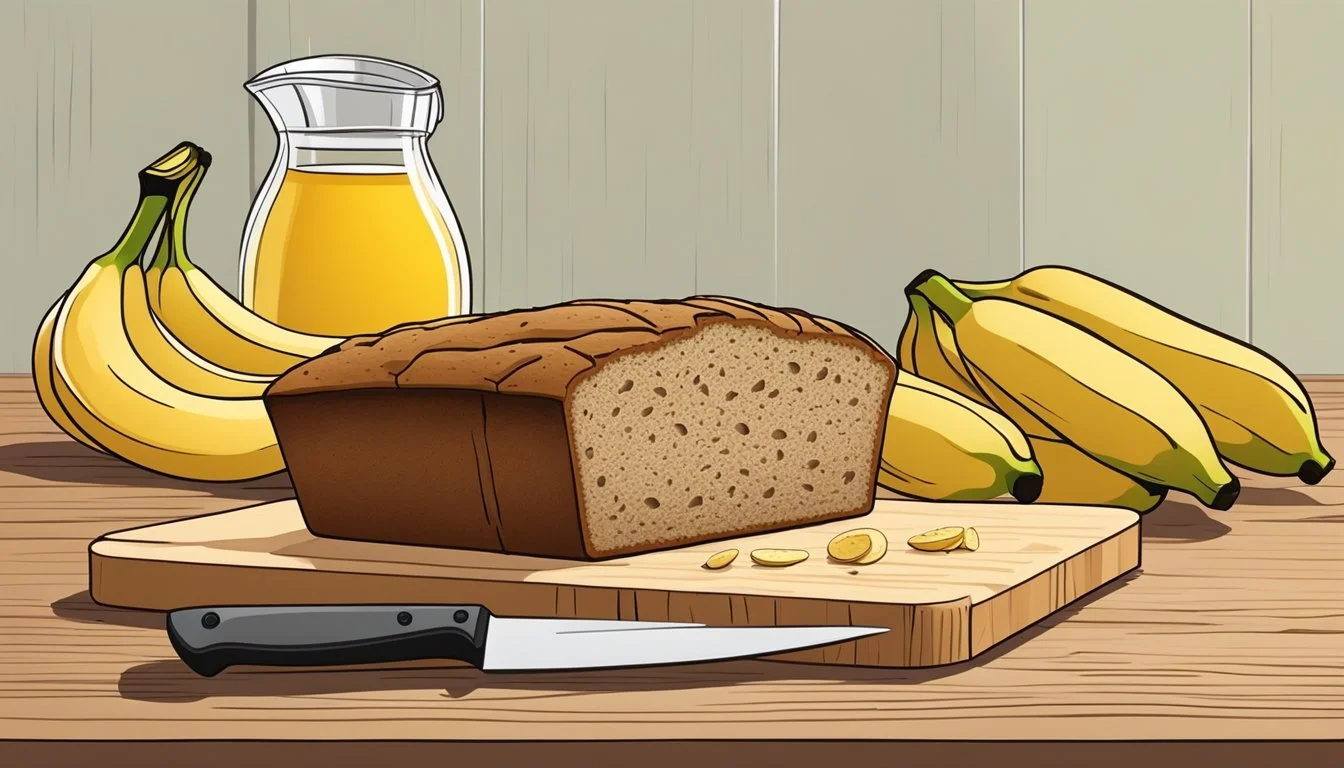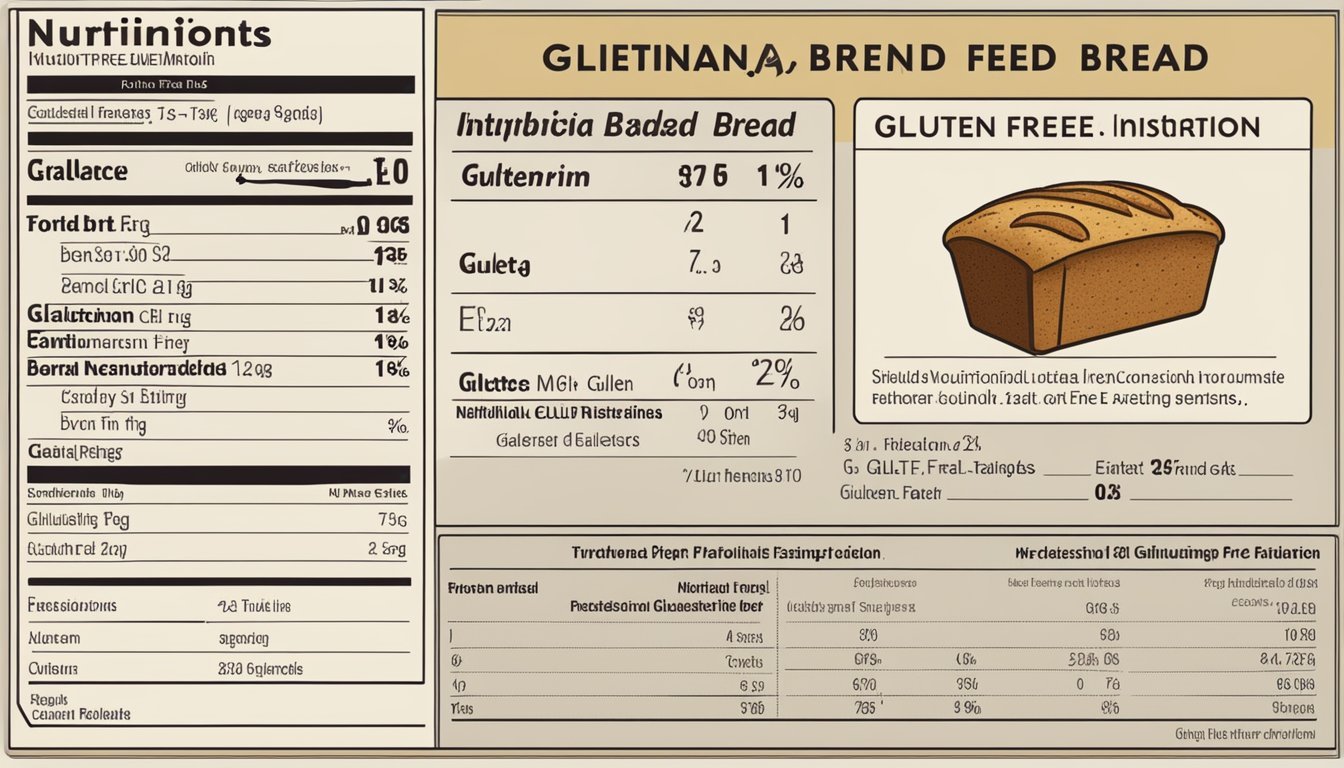Is Banana Bread Gluten-Free?
Unveiling the Truth About This Popular Treat
Banana bread (What wine goes well with bread?) is a beloved comfort food, often enjoyed for its moist texture and sweet, rich flavor. Traditionally, banana bread is made using wheat flour, which contains gluten, a protein composite that provides elasticity to dough and helps it rise. However, as public awareness of gluten intolerance and celiac disease has grown, the demand for gluten-free alternatives has risen, encouraging adaptations of classic recipes to cater to these dietary requirements.
Gluten-free banana bread substitutes wheat flour with gluten-free flours, such as almond flour, rice flour, or commercial gluten-free flour blends. These alternatives aim to mimic the structure and consistency of the original recipe while making it safe for individuals with gluten sensitivity. Key to this adaptation is finding the right blend of flours and starches to create a desirable texture, as gluten-free flours tend to lack the binding properties of wheat flour.
The transformation of traditional banana bread into a gluten-free version doesn't compromise taste or texture when done correctly. Whether the banana bread is needed for an allergy or preference, the fundamental elements of ripe bananas, a sweetener, and a leavening agent remain the same. By carefully selecting ingredients and following adjusted baking techniques, the quintessential taste and comforting quality of banana bread can still be achieved without gluten.
Understanding Gluten-Free Diets
In approaching the topic of gluten-free diets, one should comprehend what gluten is and the potential nutritional benefits a gluten-free lifestyle can offer to certain individuals.
What Is Gluten?
Gluten is a family of proteins found predominantly in wheat, barley, and rye. It acts as a binding agent, giving bread its elasticity and chewiness. For people with celiac disease, gluten triggers an autoimmune response that damages the lining of the small intestine. This can lead to gastrointestinal issues and nutrient malabsorption.
Benefits of Gluten-Free Living
Individuals who adopt a gluten-free diet often do so for health reasons. For those with celiac disease or non-celiac gluten sensitivity, eliminating gluten can lead to a significant reduction in symptoms. These could include abdominal pain, bloating, and headaches. Moreover, a gluten-free diet can bolster overall nutrition for these individuals by encouraging the consumption of more fruits, vegetables, and lean proteins. It's also important for them to seek out gluten-free grains, like rice and quinoa, to ensure balanced dietary intake.
The Basics of Banana Bread
Banana bread is a timeless comfort food that marries the sweetness and rich flavor of bananas with the satisfying texture of a baked loaf. This classic treat is a beloved staple in many households.
Traditional Banana Bread Ingredients
Banana bread typically consists of a combination of all-purpose flour, baking soda, and baking powder to provide structure and leavening. To these dry ingredients, sugar, eggs, butter or oil, and milk are added to enrich the flavor and moisture content. The star ingredient, bananas, are mashed and folded into the batter, contributing to both the distinctive flavor and the moist, dense texture.
Key Ingredients:
All-purpose flour
Baking soda
Baking powder
Sugar
Eggs
Butter/oil
Milk
Bananas
Role of Bananas in Flavor and Texture
Bananas are crucial to banana bread, serving two primary roles: they infuse the bread with a sweet, fruity banana flavor and they are responsible for the signature tender, moist texture. As bananas ripen, their starch converts to sugar, enhancing the natural sweetness and aroma that characterize banana bread. The mashed bananas blend into the batter, imparting moisture and leading to a loaf that is soft and lush.
Banana Contributions:
Flavor: Sweet, fruity banana essence
Texture: Moist, dense structure
Creating Gluten-Free Banana Bread
When preparing gluten-free banana bread, it is crucial to find the right substitute for traditional wheat flour and to understand the role of xanthan gum as a binding agent. Choosing the appropriate gluten-free flour blend and incorporating xanthan gum can yield a delicious banana bread that rivals its gluten-containing counterpart in texture and flavor.
Choosing the Right Gluten-Free Flour
For a successful gluten-free banana bread, one must select a gluten-free flour blend that closely mimics the properties of wheat flour. Gluten-free flour blends often combine various flours and starches such as brown rice flour, white rice flour, tapioca flour, potato starch, and others. Not all gluten-free flour blends are created equal; some may already include xanthan gum, while others do not. For banana bread, a blend designed for baking works best because it often includes a combination of flours and starches balanced for optimal structure and moisture retention.
Importance of Xanthan Gum
Xanthan gum plays an essential role in gluten-free baking. It acts as a substitute for gluten, providing the binding necessary to give the banana bread structure and elasticity. Without xanthan gum, the banana bread might crumble and fall apart. Most gluten-free all-purpose flour blends include xanthan gum, but if it is not listed in the ingredients, one should add approximately 1/4 teaspoon of xanthan gum per cup of flour to ensure the proper texture of the banana bread.
Gluten-Free Banana Bread Recipes
Gluten-free banana bread is a delightful treat that caters to those with gluten sensitivities without compromising on flavor. By using alternative flours and making specific ingredient swaps, these recipes deliver the classic banana bread experience in a gluten-free format.
Classic Gluten-Free Banana Bread
The foundation for classic gluten-free banana bread involves a blend of gluten-free flours—commonly a mix of rice flour, tapioca flour, and potato starch—to mimic the properties of wheat flour. Baking soda and baking powder ensure a proper rise, while a touch of salt enhances flavors. The core ingredients also include:
Bananas: Overripe bananas provide moisture and natural sweetness.
Sugar: To sweeten the bread.
Eggs: For binding the ingredients together.
Fat: Usually butter or oil for richness.
Milk or a dairy-free alternative to achieve the desired batter consistency.
Vanilla Extract: To add depth to the bread's flavor.
By creaming together the butter and sugar, and then adding the eggs, milk, vanilla, and mashed bananas, bakers create a wet mixture. The dry ingredients are whisked together separately and then combined with wet ingredients to form the batter, taking care not to overmix as this can affect the texture.
Variations and Substitutions
Those seeking to personalize their gluten-free banana bread or cater to additional dietary restrictions have a variety of options:
Egg-Free Options: A popular substitution for eggs in gluten-free baking is a "chia egg," made from ground chia seeds mixed with water that's left to gel.
Add-Ins: To enhance the bread, bakers can incorporate fruits like blueberries or nuts such as walnuts or almonds for added texture and flavor.
Dairy-Free Modifications: Substituting coconut yogurt or almond milk in place of regular dairy products can effectively make the recipe dairy-free in addition to being gluten-free.
Sugar Alternatives: For those looking to reduce sugar intake, natural sweeteners like cane sugar or even sugar substitutes can be used.
When adjusting any core ingredient in a recipe, it's important to consider how the substitute affects the overall composition and baking properties. Some substitutions may require additional adjustments, such as altering baking times or temperatures, to achieve the desired result.
Preparation Techniques
The success of a gluten-free banana bread heavily relies on how one prepares the ingredients and executes the baking process. Precision and correct temperature settings are crucial in achieving the desired texture and taste.
Prepping Your Ingredients
Before one begins mixing ingredients, they should ensure all components reach room temperature for even blending. Start by mashing the bananas until smooth, as they form the base of the bread. In a separate bowl, one should combine the dry ingredients—gluten-free flour, baking soda, and baking powder, and salt—whisking them to introduce air and avoid clumping. For optimal results, one must weigh the gluten-free flour to account for variable densities as opposed to measuring by volume.
Baking Tips for Perfect Loaf
Upon preheating the oven to the recipe's suggested temperature, which is usually around 350 degrees F (175 degrees C), one must prepare the loaf pan. Lining the pan with parchment paper or greasing it lightly can prevent sticking. It's imperative to mix wet and dry ingredients together gently to avoid overworking the batter, which can result in tough bread. Pour the batter into the prepared loaf pan and smooth the top for a uniform loaf.
Baking Essentials Details Oven Preparation Preheat to correct temperature Mixing Technique Whisk dry, fold into wet, avoid overmixing Loaf Pan Prep Grease or line with parchment paper Key Baking Times Guidelines Prep Time Varies, typically 10-20 minutes Cook Time Often 50-60 minutes, or until golden brown
One should bake until a toothpick inserted into the center comes out clean, indicating that the loaf is properly cooked through. Letting the bread cool in the pan for a few minutes before transferring it to a wire rack will help maintain its structure.
Storing and Serving Gluten-Free Banana Bread
Proper storage and reheating methods are paramount to maintain the freshness and taste of gluten-free banana bread. This guide will walk you through the best practices to ensure every slice is as delightfully tender and moist as when it was first baked.
Storing Your Banana Bread
To store gluten-free banana bread, it should be kept in an airtight container at room temperature. It typically remains fresh for up to 3 days. For optimal preservation of flavor and texture, the banana bread should be wrapped in plastic wrap or aluminum foil to prevent exposure to air, which can dry it out.
Room Temperature Storage:
Wrap tightly in plastic wrap or aluminum foil.
Place in an airtight container.
Store in a cool, dry place.
Freezing and Reheating Tips
Gluten-free banana bread can be frozen for longer storage, which is ideal for extending its shelf life up to 3 months. To freeze, first let the banana bread cool completely. Slice it before freezing if you plan to enjoy it piece by piece. Wrap each slice or the entire loaf in plastic wrap, then again in aluminum foil or place inside a heavy-duty freezer bag.
Reheating frozen banana bread is straightforward. If you prefer to enjoy it warm, you can reheat the banana bread in a microwave or oven. For the microwave, use short increments of time and check for warmth, to avoid overheating. Alternatively, the oven provides a consistent warming environment:
To Reheat in the Microwave:
Place a slice on a microwave-safe plate.
Heat in 10-15 second bursts until warm.
To Reheat in the Oven:
Preheat the oven to 350°F (175°C).
Wrap the bread in aluminum foil.
Place it in the oven for about 10-15 minutes or until heated through.
Remember, whether stored at room temperature, frozen, or reheated, the key to enjoying gluten-free banana bread is maintaining its moisture and texture while preventing it from becoming soggy or overly dry.
Nutritional Information
When assessing whether banana bread is gluten-free, it's essential to consider the nutritional information. This includes the caloric and nutrient content and the recommended portion control and serving size.
Caloric and Nutrient Content
Banana bread's nutritional profile can vary depending on the ingredients used. Typically, a slice of gluten-free banana bread contains:
Calories: 200-300 per serving
Protein: 2-4 grams per serving
Fat: 10-15 grams, predominantly from healthful sources like nuts and seeds
Carbohydrates: 30-40 grams with varying fiber contents
Sugars: 10-20 grams, which might come naturally from bananas or added sweeteners
Portion Control and Serving Size
A single serving size for banana bread is generally considered to be one slice, which can be about 1/2 to 1 inch thick. As banana bread can be dense in calories and sugars, it's advisable to enjoy it in moderation as part of a balanced diet. Portion control is crucial, especially for those who are managing their calorie intake for weight management or blood sugar control.
FAQs About Gluten-Free Banana Bread
Navigating the world of gluten-free baking can be challenging, especially when it comes to favorites like banana bread. This section provides answers and practical advice for commonly asked questions and baking tips for beginners.
Common Concerns
One of the chief concerns is whether banana bread can be made gluten-free without compromising taste or texture. It indeed can, but it requires using gluten-free flour blends that typically consist of rice flour, potato starch, and tapioca flour. It's important to avoid cross-contamination with gluten-containing ingredients, which can happen through shared utensils or unclean kitchen surfaces.
Another frequent question regards the shelf life of gluten-free banana bread. Since it often lacks preservatives found in traditional baked goods, it is best consumed within a few days of baking. Alternatively, it can be sliced and frozen to extend its freshness.
Tips and Tricks for Beginners
For those starting out with gluten-free baking, here are a few tips:
Dry Ingredients: Measure gluten-free flour blends accurately using the spoon and level method. Sifting flour prevents clumping and ensures lighter bread.
Wet Ingredients: Overripe bananas give moisture and sweetness. One should mix wet ingredients like banana, eggs, and oil until well combined before incorporating the flour mixture.
Mixing Technique: Gently fold the dry ingredients into the wet to avoid overmixing, which can make the bread dense.
Baking: Preheat your oven to ensure a consistent baking temperature. Use an oven thermometer for accuracy.
Each step is crucial to achieve the desired result: a moist and flavorful gluten-free banana bread. Remember, practice makes perfect, and each attempt helps one learn and refine their baking skills.





